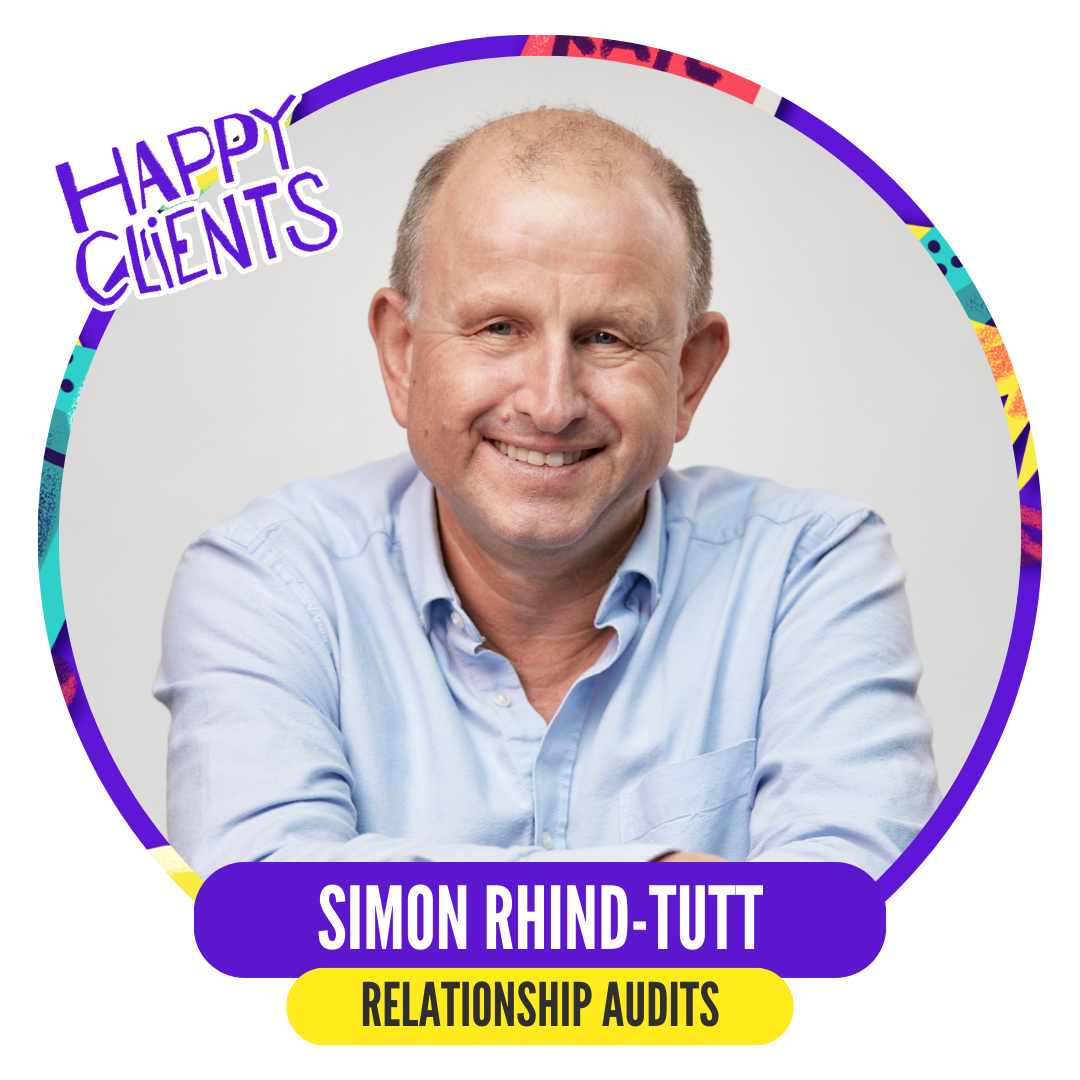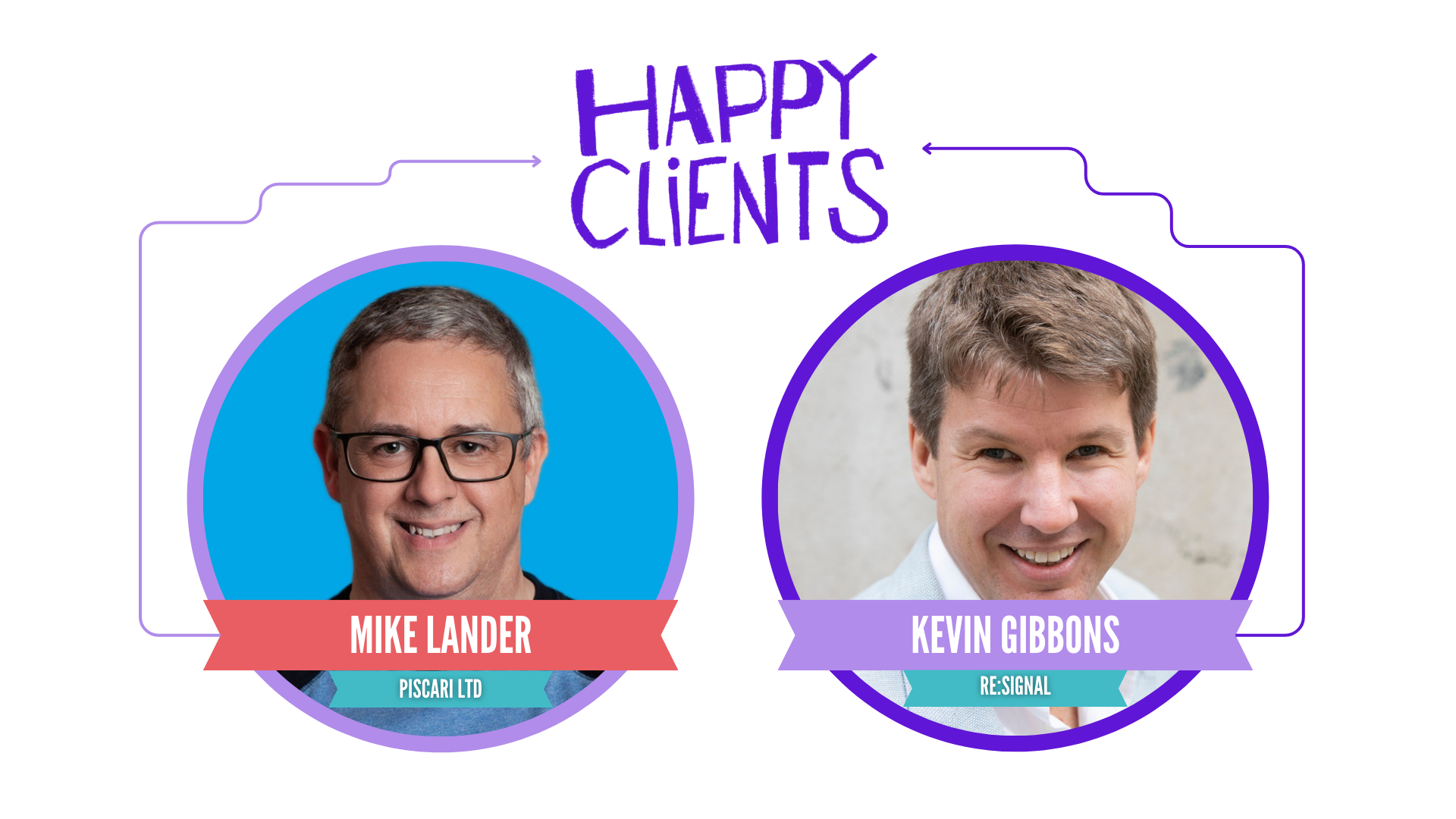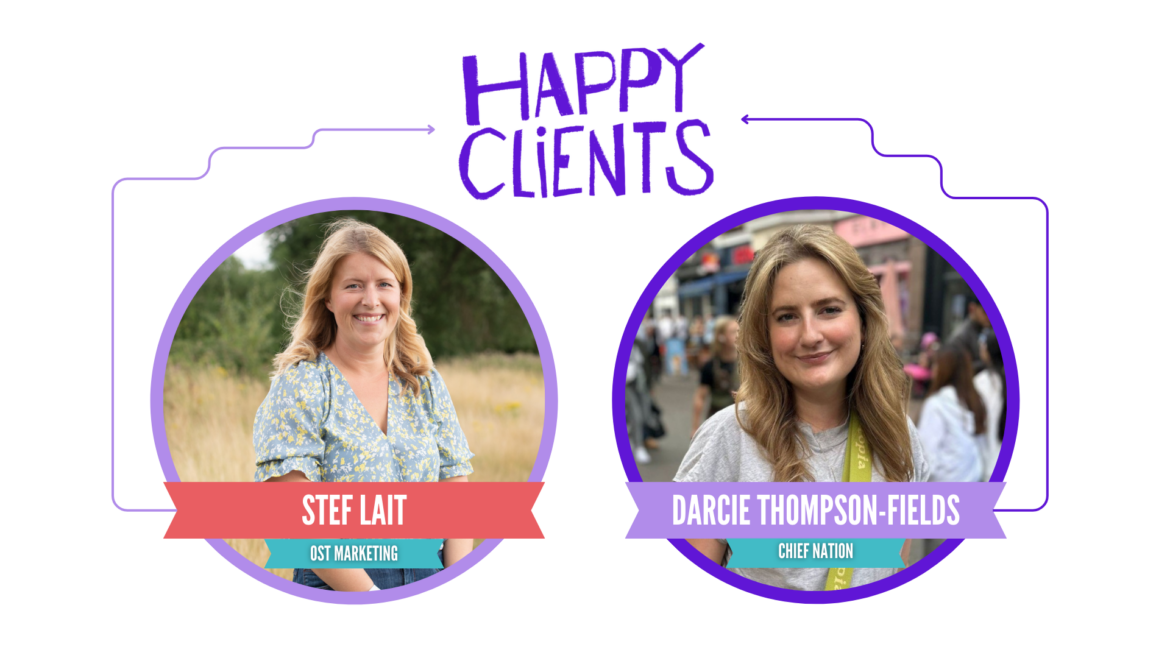Speakers
📢 Here are the current speakers we have for this event. We will also hear from you – the event is all about taking part.
How Client Conferences Can Make Your Agency Indispensable

Brightec noticed something curious about their clients – many of them faced similar problems.
As the business developer for the mobile app development agency, Simon Brading wanted to help.
“Some of the issues that these guys are facing, they’re actually also facing the same issue. What if we could bring our clients together for the day and give them a space to talk to each other?” Simon explains.
Simon’s goal was to create a unique, high-value event where clients could come together, learn from each other and develop practical solutions. Somewhere their clients could feel inspired and understood – whilst enriching their network.
After discussing the possibilities, they landed on a bold idea the Brightec Exchange, an all-day event gathering their client base and wider network together for knowledge sharing, problem solving, and peer learning
They mapped out their clients’ biggest needs, from fulfillment and shipping headaches, to scaling internationally – and paired them with leading voices that could help them find solutions.
- They won new business – more than covering the cost of the day.
- 50% of attendees said one of the keynote speeches was “life-changing”.
- The event deepened existing relationships, turning professional contacts into trusted partners.
- Brightec showcased the strength and diversity of its client network – boosting credibility across sectors.
More importantly, clients walked away more confident in their relationship with Brightec, with the event securing their status as a key strategic partner who invests in their clients’ success.
“It helped them work out their problems, and it helped us understand them better. The day was a win-win for everyone,” says Simon.
At Happy Clients, Simon will share how being a driving force for solutions can secure new business, increase value and strengthen relationships.
How a Secondment Won Our Agency a Major Client Account

Jenny kept coming up against the same problem.
Growing a major account was near impossible due to lengthy client approval processes killing time-sensitive social campaigns.
As the strategy director for Jwoo, a theatre, arts and entertainment digital agency, she’d been working with one particular client for over four years, but a larger agency had always handled the majority of their organic socials.
Then, the client approached Jwoo with an idea that would change everything.
They needed an extra pair of hands in their internal marketing department and asked if a member of the Jwoo team would consider taking a secondment with them.
Only they didn’t need someone for a day, a week, or even a month. They were initially looking at a six-month stint.
While Jenny was interested in the opportunity, she had concerns about her reduced involvement at Jwoo, but ultimately realised just how valuable this level of time spent with the client could be.
While on her secondment, she presented to the leadership board, was involved in high-level meetings, and played a key role in decision-making.
“I learnt to speak their language – understanding their priorities, challenges, and ways of working. Once I adapted to their communication style, everything became more efficient. Conversations flowed better, decisions were made faster, and we were able to collaborate more effectively to drive results.”
Communication became more efficient, and approval processes were streamlined. As a result, Jwoo now manages 100% of the client’s organic social.
At Happy Clients, Jenny will share how a secondment can increase trust, improve efficiency and make your agency the ‘go-to’ for key clients.
Workshop: Turn Difficult Conversations Into Win-Win Outcomes

Trenton was facing the dreaded scope creep.
Unbillable hours were piling up as a client kept shifting the goal posts by requesting “small” amends, which had a big impact on the overall project and budget.
He knew a difficult conversation was on the horizon.
Or was it? Trenton had a brilliant idea – what if the key to tricky client conversations was listening like a counsellor, not a project manager?
Drawing on years of coaching and his time as a Samaritans volunteer, Trenton used deep listening and guided discovery to uncover what the client truly needed.
“By getting to the real issue, we were able to stop the revision cycle and agree on what success looked like – for them and for us. You’re not saying, ‘Sit on my couch and tell me how you feel’ – but it’s still the same techniques a counsellor would use, just in a client meeting.
You can’t create a win-win if you don’t know what a win looks like for both sides.”
Trenton’s methods had a massive impact on his agency:
- Prevented scope creep.
- Minimised rounds of revisions.
- Reduced unbillable hours.
- Sped up sign-off.
“Normally, we’d say, ‘We’ve done 17 amends; we can’t keep going.’ But instead, we said, ‘We’re committed to your outcome and also to us getting what we need – let’s work out a win-win.’ And it changed everything.”
At Happy Clients, Trenton will run a highly interactive workshop to equip you with everything you need to truly understand your client’s needs, turn tricky conversations into productive ones, and create an outcome that works for everyone.
Client Love Languages: Understanding Your Clients’ Communication Styles

“The client went absolutely apeshit.”
That’s when Daisy Whitehouse, founder of Down at the Social, knew something in her agency had to change.
The unhappy client wasn’t annoyed with the standard of work, budget or project timeline. So, what had caused them to become so upset?
During a Zoom catch-up, a member of Daisy’s team paused the call mid-meeting so that they could reply to a different client’s email.
The team member didn’t see a problem. But the client certainly did, as did Daisy.
“They just didn’t realise how it came across to the client. And that’s when it clicked – we needed a better way to help the team, especially the Gen Zers, understand how different clients want to be treated.”
While wracking her brain for a possible solution, she found her answer in the unlikeliest of places: Love Island.
“I was watching, and they kept talking about love languages, and I thought, ‘Why not have love languages for clients?”
Inspired by the pop culture concept, Daisy built and implemented a framework that helps her team attune their approach to every client’s emotional style.
Things have improved already:
- Communication has become more consistent and tailored to each client’s needs.
- Relationships have become thoughtful, personal, and friction-free.
- Team confidence has improved as they’ve become empowered to deal with all kinds of interactions.
“It’s already helped us rethink how we manage clients on a day-to-day basis – how we communicate, how we report, even how we structure accounts.”
At Happy Clients, Daisy will share how she’s using ‘love languages’ to decode client relationships. You’ll learn how to map your clients and tailor your comms style to suit them. It’s a unique idea that’s making a big impact.
Why Happy Clients Still Leave: And What Really Makes Them Stay

“If you’re only doing what a client has asked, you’ll be replaced.”
As co-founder of the global relationship experts, Relationship Audits®, Simon understands what clients really want in 2025, and it’s much more than you might expect.
“Happy clients still leave. Agencies need to prove their value – or risk losing their role entirely.”
Through conducting thousands of client interviews, Relationship Audits® has unearthed why satisfactory work is no longer enough.
In this data-led keynote, Simon will share:
- Why the bar for client happiness is higher than ever.
- The hidden levers that drive long-term relationships.
- What clients wish agencies understood (but don’t always say).
- How AI and big tech are shifting expectations.
- Practical ideas to stay relevant, respected, and indispensable.
Whether you’re a founder, client services professional or part of a growing team, Simon’s session will give you practical ways to build deeper partnerships, grow revenue and turn your clients into your most powerful new business generators.
How to Manage Difficult Client Behaviours

Catherine knows about challenging client behaviours.
From confusing briefs to unrealistic deadlines – she’s familiar with the impact these habits can have on an agency, but what about their root cause?
As the client partner for digital agency Numiko, Catherine’s focus is on making sure their clients are happy. To do this, she needs to know what makes them unhappy.
Luckily, she had the perfect opportunity – Numiko’s client conference.
They gathered over 100 clients together to discuss innovation, strategy, and sustainability, while in a setting that encouraged idea sharing and relationship building.
Catherine ran a segment focused on identifying and addressing the client behaviours that often lead to project challenges. Her goal was to understand what internal problems were causing tricky client behaviours.
How she approached this was genius.
Instead of telling clients about their challenging behaviours and risk offending or alienating them. She instead asked what behaviours they thought might make a tricky client.
Amazingly, their answers aligned with hers!
Once the conversation had been opened up, she was able to ask them about the cause of challenging client behaviours.
Their answers were invaluable:
- Lack of internal stakeholder alignment.
- Absence of a clear, long-term strategy.
- Changeable budgets.
- Ineffective briefing processes.
This information allowed her to implement changes that improved Numiko’s internal processes and in turn, helped her clients.
She brought in:
- Stakeholder mapping.
- Structured project frameworks.
- Budget guidelines.
- Clearer briefing templates.
“When you invest time in truly understanding what your clients are going through, you’re not just solving a problem – you’re building a partnership.”
By addressing these issues head-on, she helped the agency provide better support, ultimately leading to improved client satisfaction scores.
At Happy Clients, Catherine will share how to uncover the root causes of your client’s woes and implement practical changes that improve both your agency’s processes and your clients’ happiness.
How to Scale Your Agency and Land Bigger Clients

Mike has some advice that you might not be ready to hear.
As the chief executive officer of B2B sales consultancy Piscari Ltd, Mike’s seen time and time again that if you want to attract bigger clients, the answer is clear: you must be willing to shrink in order to grow.
“If you work with smaller clients, you get referred to smaller clients, and then you’ve got a portfolio of small clients. Unless you deal with the historical culture of working with 10 small clients, it’s pointless.”
Agencies can get stuck with small-fry clients when they dodge the bold moves needed to snag the bigger, fatter accounts.
To make the switch and scale up, Mike says there are several key steps every agency leader must take:
- Identify and remove low-profit clients.
- Rehire and restructure to ensure your team is capable of managing bigger and more demanding clients.
- Ensure there’s enough capital and cash flow to see you through the transitional period.
- Be willing to make tough, strategic decisions that initially shrink the business before enabling sustainable growth.
“If you plan carefully, you can make it work. It’s all about a measured approach, client by client, to create a healthier, more profitable business.”
At Happy Clients, Mike will be joined by Kevin Gibbons, founder and CEO of Re:signal, a specialist e-commerce SEO agency. Together, they’ll present a real-life case study illustrating how Re:signal successfully transitioned to landing bigger clients through the co-development of a tailored systematic approach. Mike will outline a repeatable, structured framework, offering actionable and practical guidance for agencies aiming to scale effectively and avoid the over-servicing trap.
Breaking Silos: The Client Services Leader as Internal Orchestrator

“You often have to become the peacekeeper.”
For Rachel Raphael, this is the role of many client services leaders today – stuck smoothing over internal chaos, while trying to look composed for clients.
But it’s not good enough to adapt the delivery. It’s about how the machine behind the delivery is working. Or more often, how it isn’t.
“Clients aren’t stupid,” she says. “They know when things are broken.”
There’s often an invisible problem, or friction, when it comes to client work – creative pulling one way, strategy pulling another, with client services caught in the middle. This leaves teams with no authority, no shared rituals, and no sense of shared ownership.
And in a world where briefs evolve mid-project, teams are hybrid and fluid, and decisions need to happen in real time – that internal alignment matters more than ever.
This session is all about challenging this situation, and reframing client service leaders as the conductor of an orchestra, rather than just a go-between.
And for Rachel, a key part of this is what she calls the magic triangle.
“It’s about bringing together these teams – client services, strategy, and creative, in whatever guises they are in your agency,” she explains. “You’re not opponents. You’re a collective team. That’s where the magic happens.”
But this isn’t just a mindset shift – it’s a structural one. By focusing on things running smoothly internally, the client will definitely feel a difference on the outside.
At Happy Clients, Rachel will share how to build the internal rhythms and rituals that make collaboration real and how client service leaders can shape delivery from the inside, even without formal authority.
How To Set Client Services Up for Success – A Practical Framework

“Client services shouldn’t be about putting out fires.”
So why are project leads often left picking up the pieces instead of steering the ship?
Sally Stevens has the answer.
As a client services strategist, Sally began her career brand-side before moving into agency life – first permanently, then as a freelancer. She’s spent years parachuting into agencies mid-crisis. From covering for stress leave to rescuing spiralling projects, she’s seen firsthand what causes things to go off the rails – misalignment.
“I had one client where I realised we were completely misaligned. I thought we were doing one thing – they thought we were doing something else. That’s when you have to pause, before it gets toxic, before trust erodes, before the wheels fall off.”
When agencies and clients aren’t aligned, it’s a slippery and predictable slope:
- Expectations aren’t set.
- Assumptions pile up.
- Account managers are left trying to hold it all together.
Having watched this cycle repeat across countless agencies, Sally decided to take action and created the ‘Brilliant Blueprint’ – a practical, three-part framework that helps agencies:
- Reset their client relationships.
- Set clear, proactive expectations for the agency and client.
- Give account teams the structure, confidence, and tools they need to lead, alongside a safe space to speak up when they need help.
The result? Calmer clients, more empowered account teams, and stronger long-term partnerships, which leads to better work.
“It’s about moving account managers out of survival mode – and into the role they’re meant to play: proactive, respected, and central to great client relationships.”
At Happy Clients, Sally will share her framework for getting your client services professionals out of firefighting mode and back where they belong – leading, guiding, and holding the agency-client relationship together.
Complaints Are a Compliment: Why All Client Feedback Is Good

“There’s another agency that can do it for half the price.”
It’s the last thing most agency leaders want to hear – but for Fiona Skilton, it’s a compliment.
As client services director at Collective Content, Fiona welcomes uncomfortable conversations with her clients.
“Weirdly, I do take it as a compliment if they say, ‘I’m not happy about this,’ because it indicates that they want to fix it. Otherwise, why would they bother saying anything?”
For example, one client came to her with cost concerns. Under pressure to justify spend, they’d found a cheaper agency abroad – but instead of walking away, they came to Fiona first. That gave her the chance to adjust: she streamlined internal processes and limited rounds of feedback, all without sacrificing quality.
The result? The agency retained the business and proved to the client that they were willing to adapt to their needs.
But great client service isn’t just about giving clients space to speak up – it’s also important to never mistake silence for satisfaction.
“If they go quiet, it’s not necessarily initially an indication of unhappiness. But the longer you leave them, the more likely they are to think, ‘Does my agency care about me?'”
In this session you’ll learn:
- Why client complaints can be a positive sign.
- How to respond to feedback without defensiveness.
- Ways to stay proactive and avoid client drift.
At Happy Clients, Fiona will share her unique take on negative client feedback and offer tangible advice on how to implement a system that keeps you and your clients on the same page.
Client Services Surgery

One minute you’re having a tricky conversation and the next you’re untangling a confusing brief, all while dodging the dreaded scope creep.
Sound familiar? If so – you work in client services!
It’s all part of the job – but far too often, client services professionals are left to power through the day-to-day without the benefit of a second opinion or sounding board.
That’s exactly why we created Happy Clients Surgery Sessions – a safe, supportive space to share your challenges, swap ideas, and get practical advice from others who really understand.
We’ll be joined by:
- Darcie Thompson-Fields, Client Services Director at Chief Nation.
- Stef Lait, Client Services Director at OST Marketing.
They’ll be on hand, alongside a room full of your peers, to offer advice and have an honest conversation about the challenges client service teams are facing right now.
Bring your stories. Bring your questions. Bring those “what would you do?” moments. Or just come along to listen, learn, and feel a little more human in the chaos.
